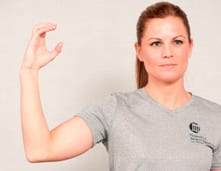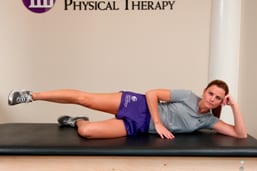Do you suffer from hip pain? Erica Elsasser, PT, DPT, cert MDT at our partnership clinic with Nashville Hip Institute, explains the causes of hip pain in this article. Please read below to see how a qualified physical therapist can help reduce your hip pain and increase your quality of life.
Hip Pain
Femoroacetabular Impingement (FAI) and Labral Tears
Hip pain can manifest itself in many different areas of the hip. Many patients with hip pain will complain of anterior (groin) or lateral hip pain commonly cupping their lateral hip with their hand creating a “C” with their hand. This is called a “C” sign (see picture below) and can indicate hip joint pain.
Many patients are diagnosed with trochanteric bursitis, but there may be more going on. The term femoroacetabular impingement (FAI) has been around for years now, but patients are not always diagnosed with this initially. FAI is described as a congenital bony defect on either the head-neck junction of the femur (long leg bone) or on the acetabulum (hip socket). The extra bone or “bump” on either side of the bone can cause wear and tear on the cartilage and/or cause the labrum to tear. This can cause anterior (groin) pain, lateral hip pain, referred pain down the front of the thigh to the knee, or less commonly posterior buttock pain. Common activities that are painful or limited due to hip pain from FAI or labral tearing are prolonged sitting, getting into/out of the car, putting on socks/shoes, prolonged walking, and higher-level sporting activities that include loaded rotational movements such as hockey, baseball, and soccer. Early recognition and diagnosis can prevent damage to the cartilage and labrum. Conservative treatment focusing on hip/core strength training (see examples of exercises below), postural training (maintaining a neutral pelvis to decrease pressure on the front of the hip), and modification of current activities can help prevent further damage and pain.
Hip osteoarthritis (OA) is also commonly seen in patients with hip pain. With hip OA, patients will have the most pain with weight-bearing activities such as walking. Modifications of current activities and adding pool therapy would be beneficial to help decrease the stress on the hip joint.
Examples of core/hip strengthening exercises:
Double Leg Bridge
Clamshells






